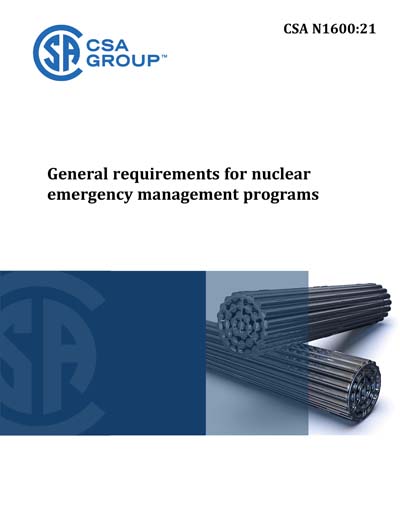Most recent
CSA N1600-2021
General requirements for nuclear emergency management programs
Preface This is the third edition of CSA N1600, General requirements for nuclear emergency management programs. It supersedes the previous editions published in 2016 and 2014. Major changes to this edition include the following: a) additional requirements and guidance on recovery planning and improved alignment with related industry standards, including IAEA No. GSR Part 7 and IAEA No. GSG-11; b) additional clarification on the distinction between drills and exercises, and their associated expectations; c) introduction of the concept of a protection strategy, consistent with Health Canada’s Generic Criteria and Operational Intervention Levels for Nuclear Emergency Planning and Response, with clarification regarding the application of reference levels, generic criteria, operational intervention levels, and protective actions; and d) clarification regarding communication and engagement with other organizations, communities of interest, and Indigenous peoples. This Standard provides requirements for a comprehensive nuclear emergency management program (NEMP) embracing the emergency management components (prevention/mitigation, preparedness, response, and recovery) in keeping with international emergency management practice, with a predominant focus on preparedness, response, and recovery. It establishes the elements of a continual improvement process to develop, implement, maintain, and evaluate the emergency management functions of reactor facilities and their surrounding communities. Users of this Standard are reminded that the site selection, design, manufacture, construction, installation, commissioning, operation, and decommissioning of reactor facilities in Canada are subject to the Nuclear Safety and Control Act and its Regulations. The Canadian Nuclear Safety Commission (CNSC) might impose additional requirements to those specified in this Standard. The CSA N-Series Standards provide an interlinked set of requirements for the management of reactor facilities and activities. The CSA N286 Standard provides overall direction to management to develop and implement sound management practices and controls, while the other CSA nuclear Standards provide technical requirements and guidance that support the management system. This Standard works in harmony with CSA N286 and does not duplicate the generic requirements of CSA N286; however, it might provide more specific direction for those requirements. Scope 1.1 Reactor facilities This Standard establishes criteria for the emergency management programs of on- and off-site organizations to address nuclear emergencies at Canadian reactor facilities. Notes: 1) This Standard may provide guidance for nuclear facilities other than reactor facilities. The operators of these facilities may, together with the AHJs, determine the applicability and suitability of the guidance provided by this Standard. 2) The requirements in this Standard are applied in accordance with the applicable legislation and jurisdictional responsibilities of the organization. 1.2 Emergency management pillars This Standard provides the requirements to develop, implement, evaluate, maintain, and continually improve a nuclear emergency management program (NEMP) for prevention, mitigation, preparedness, response, and recovery from a nuclear emergency at a reactor facility irrespective of the initiator. Note: The requirements and guidance in this Standard could inform the development of plans for specific initiating events (e.g., fire, flood, security). 1.3 Business continuity planning This Standard does not establish requirements for business continuity planning. Note: For further information on continuity planning, see CSA Z1600 and ISO 22301. 1.4 Mandatory language In this Standard, "shall" is used to express a requirement, i.e., a provision that the user is obliged to satisfy in order to comply with the standard; "should" is used to express a recommendation or that which is advised but not required; and "may" is used to express an option or that which is permissible within the limits of the standard. Notes accompanying clauses do not include requirements or alternative requirements; the purpose of a note accompanying a clause is to separate from the text explanatory or informative material. Notes to tables and figures are considered part of the table or figure and may be written as requirements. Annexes are designated normative (mandatory) or informative (non-mandatory) to define their application. 1.5 Use of "consider" In this Standard, "considered" or "consider" means that the user evaluates the impact and documents any decisions.
Content Provider
CSA America, Inc. [csa]






